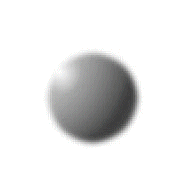

"I showed that the universal medium is a gaseous body in which only longitudinal pulses can be propagated, involving alternating compressions and expansions similar to those produced by sound waves in the air. Thus, a wireless transmitter does not produce Hertz waves, which are a myth, but sound waves in the ether, behaving in every respect like those in the air, except that, owing to the great elastic force and extremely small density of the medium, their speed is that of light." - Nikola Tesla

I wanted to attempt a replication myself of the type of equipment which Townsend Brown used to send signals of an electrogravitational nature. Initially I thought that this would be as simple as impressing a high voltage pulse onto the right type of antenna. This in itself proved a problem, as Brown's antennae were made of metal, very difficult for me to obtain the required mass and shape to charge the apparatus. What I put forward here is a partially complete proposal for a system which might be able to send single-spike gravitational waves, using a high voltage pulse.
The pulse is the starting point. This is the energy needed to cause the electrogravitational coupling to become visible. With this in mind, I have created a very large capacitor specially for the purposes. It is a cylindrical rolled capacitor with aluminium foil for plates, and polyethylene dielectric. This dielectric is the type used for damp-proofing houses, being 250 microns thick. I quadrupled this over to provide a 1000 micron layer (one millimetre). Given that the breakdown voltage of polyethylene is 1200 volts per mil (one mil is .001 of an inch), this gives me a breakdown voltage of 48,000 volts for the capacitor. The plate area of the capcitor is 3 square metres per plate. This is a good starting point.
The next most important thing to be considered is the antenna. Brown used a highly conductive metal like lead or iron. I am unable to make use of these, so I have decided to take another approach. Since a hot solvent can hold more of a solute than a cool one, I considered using hot (perhaps 90 degrees celcius) water with potassium chloride dissolved into it to give me plenty of ions for conduction. Hopefully, with a saturated solution and a high enough voltage, this would enough for me to propagate some kind of gravitic signal.
Assuming that the capacitor charges fully to 48 kilovolts, the next thing to discuss is the discharging control. To create the signal, the ideal situation is to discharge the entire capacitor as quickly as possible onto the antenna. This is good for producing gravitic signals, but is also pretty dangerous - thousands om amperes might flow for an instant in the wires if the resistance was low enough. The discharging is the most dangerous part of the process. Finally, I will not be leaving the voltage unchanged - I intend to pass the pulse through a tesla coil style step-up inductor wound round the base of the antenna stand, probably to act as a voltage tripler. With an air core, this will not be terribly efficient, but the enormous energy from the capacitor should be enough to allow an effect to manifest. The end pulse will hopefully be approximately 145 kilovolts, energy level unknown (depends on the KCl solution inside the antenna to provide a load). This is laid out in the diagram below. Detection means for the gravitational signal (if any) produced are still under review.
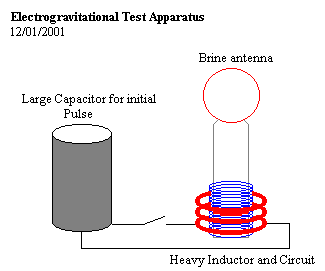
I imagine that this device will be built and ready for testing soon. I will keep you all posted. If you have any questions, please mail me. I am also a regular on William Beaty's FreeNRG-L list for those of you who have access to this.
Full details of the original device are contained here, in a PDF file. The illustrations are mising, so I have endeavoured to create suitable examples here. The heavy mass described is connected to a high-frequency oscillator through an inductor. The whole transmitter is then encased in as good a Faraday cage as possible. The suggestion was to bury the device hundreds of metres inside a mountain where no electromagnetic radiation could penetrate. This is vital, in order to identify the radiation as electrogravitic rather than electromagnetic, and lend credibility to the apparatus.
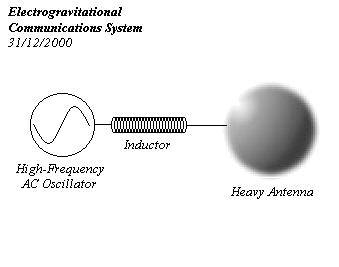
To receive the signal, another similar device is required, only smaller. A similar arrangement is used, as below.
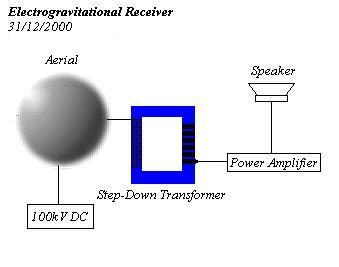
The signal encounters the charged mass of the receiving antenna, and impresses its own signals upon it, making a copy of the original oscillations. This arrangement would be employed aboard ships or other vehicles, but the mass of the transmitter and receiver seems prohibitive for domestic usage. Another inventor believes he has found a way to easily pick up "gravitic" signals......

Invented by Greg Hodowanec, this circuit is purported to receive gravity wave signals. The circuit is below.
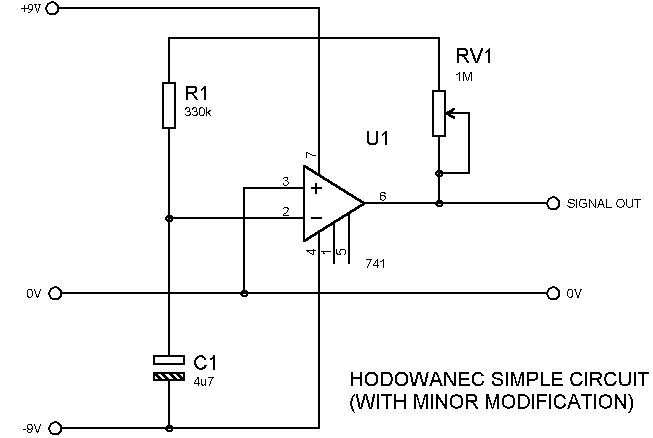
This circuit will recieve the signals, but in order for these to be heard (and thus to rule out commercial and stellar radio sources), a speaker and other amplifiers are required. The Hodowanec circuit is controversial because of some of the other claims made by Hodowanec himself. He claimed that he was in contact with an ancient civilization living on Mars and communicating using gravity waves. The basic ideas he put forward are in line with Brown's work though. Hodowanec claimed that ambient gravitic radiation affected the charge on a capacitor, and that a specific antenna is not required. Though Brown's heavy antenna could be considered a capacitor, it is not strictly so, and the principle is different. By charging the capacitor and amplifying the oscillations impressed upon it by the "gravity signals", he claimed to be able to pick up gravitic radio messages.
I have not built or tested either of these devices at this time, and this may prove difficult as casting lead spheres is both time consuming and dangerous. If another easily shapeable conductor (liquid brine?) could be used to generate signals, this could prove to be a very useful means of propagating unstoppable signals.